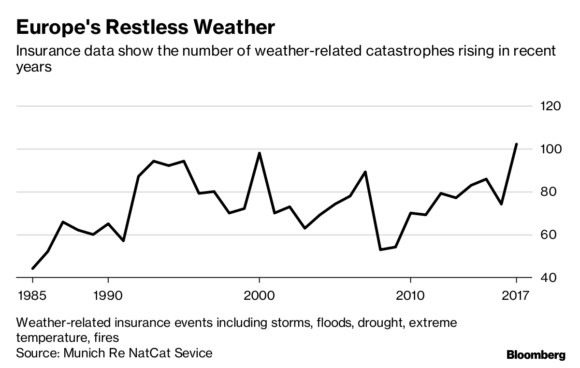Hannele Arvonen, the owner of one of Sweden’s largest lumber yards, is spending the winter months planning for a new and unexpected threat to her business: regular wildfires raging just south of the Arctic Circle.
Her business, Setra Group AB, had a tense summer as firefighters fought back fires raging through Sweden’s densely-forested Gaevleborg region during a drought that lasted months. Workers there are still painstakingly trying to recover sellable wood from the charred remains of tree stumps.
The incident is one of dozens highlighting the cost of a rapidly changing climate across Europe. The insurer Munich Re says this year may be on track to break the record for the number of weather-related catastrophe events racked up in 2017, when damages totaled more than 15 billion euros ($17 billion). From German steelmaker Thyssenkrupp AG to British food retailer Greggs Plc, companies are warning that unexpected fluctuations in the weather events are hurting production and sales.
“The weather has been changing for years,” said Arvonen, who is chief executive officer of the company based in Solna just north of Stockholm. “We’re planning for this happening every summer.”
The experiences of these companies show why Europe is leading the international effort to rein in fossil fuel emissions, which steps up pace this week at a round of talks organized by the United Nations in Poland. Envoys from almost 200 nations are working on a rule book to implement the landmark Paris Agreement, where countries rich and poor alike pledged to rein in the greenhouse gases blamed for increasing global temperatures.
About one-in-four of the leaders of European companies are “extremely concerned” about the impact climate change is having on their business, according to a study by PwC Consulting. Temperatures have already risen about 1.4 degrees Celsius across Europe since the start of the industrial revolution, and that has disrupted the westerly winds that for centuries dictated the continent’s relatively predictable weather.
The result is heavier flooding in coastal areas and more frequent dry spells, like the kind that led to wildfires in Sweden. While scientists say it’s impossible to link any single weather events to global warming, the likelihood of such floods, fires, droughts and storms occurring will continue to rise along with the average temperature.
“It’s safe to say weather events have been changing,” said Douglas Crawford-Brown, professor of climatology at Cambridge University in England. “Statistical analysis suggests these events have increased along with the rise in temperature.”
The political winds aren’t all blowing in favor of climate action. In France, Gilet Jaune or Yellow Jacket protesters rioted last week against Emmanuel Macron’s fuel taxes, which are aimed at reducing greenhouse gas emissions. In Germany, Angela Merkel’s government is listening more carefully to industry and energy consumers who voice concern about how much renewable power sources are adding to electricity bills. And across the Alps in Italy, the populist government is backtracking on its wide-eyed enthusiasm for renewables as it struggles to control the country’s teetering sovereign debt pile.
Even so, once rare events like the wildfires in Sweden are causing an increase in economic damage that companies are just starting to grasp.
Thyssenkrupp and BASF SE both announced production cutbacks after a protracted drought in Germany made the Rhine River impassable for ships that transport their products to the world. The drought caused gasoline shortages in the German state of Baden Wuerttemberg, home state to automakers Daimler AG and Porsche AG. BASF in a profit warning issued Monday said low river levels due to hotter weather would cost it up to 200 million euros.
In Britain, Greggs shares were hit in May after a cold snap late in the spring kept customers out of its sandwich shops. While the company bounced back with stronger sales more recently, unusual weather is starting to become more routine.
Heatwaves like those that wrecked crops in Germany and Poland in 2017 and 2018 will probably be the norm by 2050, according to Joanna Haigh, professor of atmospheric physics at Imperial College London.
“The crop losses this summer were huge,” said Christa-Maria Wendig, a grain farmer in the Brandenburg countryside outside Berlin who almost went bust during the fourth drought in just a few years. “We need to learn to live with more regular droughts.”
While northern Europe roasted in warmer than usual temperatures, the continent’s Mediterranean rim faces floods and more intense storms as higher temperatures increase the amount of water vapor in the atmosphere. In Italy, once-rare weather phenomena like tornadoes and water spouts now happen regularly, according to Daniele Spizzichino, senior climatologist at the Italian Institute for Environmental Protection and Research.
Flash floods that tore through several towns in southwest France following an overnight storm in late October, as the River Aude burst its banks following the heaviest rainfall exceptional rainfall in more than a century, the French agency that monitors flood risks said. Those floods killed 13 people and caused over 35,000 insurance claims for 200 million euros in damage, according to the French Insurance association.
Climatologists think French businesses will have to get used to it.
“The hotter the air, the more moisture it can store,” said said Yves Tramblay, a hydrologist at the University of Montpellier. “In theory, an extra degree Celsius translates into an additional 7 percent humidity. If temperatures continue to rise, Mediterranean episodes will become more intense.”

Related:
- Extreme Weather Risk Grows as Warming Earth Disrupts High-Altitude Winds: Study
- July’s Droughts, Wildfires, Floods Caused Billions in Global Economic Losses: Aon
- Fires, Floods & Heatwaves on 3 Continents: Blame the Jet Stream, a Warming World
- Extreme Weather in Europe and Asia Sparks Wildfires, Floods
- California Wildfire Continues to Grow Near Yosemite
- Wildfires Burn in Texas as High Heat, Low Humidity Persist
- Sweden Wildfires Destroy More Than $100M Worth of Forested Land
- Greek Wildfires Claim at Least 74 Lives in Worst Blazes Since 2007
Was this article valuable?
Here are more articles you may enjoy.


 Nursing Homes Struggle With Trump’s Immigration Crackdown
Nursing Homes Struggle With Trump’s Immigration Crackdown  Louisiana Insurers Must Disclose Prior Policy Premiums Under Controversial New Law
Louisiana Insurers Must Disclose Prior Policy Premiums Under Controversial New Law  Ken Griffin-Backed Florida Bill for Non-Competes Becomes Law
Ken Griffin-Backed Florida Bill for Non-Competes Becomes Law  California Surplus Lines Take-Up Soars as Brokers Work to Find Coverage for Clients
California Surplus Lines Take-Up Soars as Brokers Work to Find Coverage for Clients 

